Astronomical events of the month of May 2023
The month of May will give us the opportunity to learn about some of the achievements of the European Space Agency (ESA). Likewise, we will have the opportunity to marvel at a moderate meteor shower, the Aquarids, as well as some of the most interesting Messier objects such as M4, M5 and M13. In addition, we will have the opportunity to appreciate a remarkable conjunction between the planet Mars and the Moon. Of course, the ephemeris of the phases of the Moon cannot be missing.
The ESA
The European Space Agency (ESA) is an international organization of European states dedicated to space exploration, with 22 member countries. It was established on May 31, 1975. This important agency has been vital so that, together with its North American counterpart, NASA, join efforts to give us a new vision of the cosmos. Among his most transcendental projects are:
• Hubble Space Telescope in collaboration with NASA, launched in 1990.
• SOHO in collaboration with NASA, launched in 1995.
• Mars Express launched in 2003.
• Gaia space observatory, launched in December 2013
• James Webb Space Telescope in collaboration with NASA, launched in December 2021.
• AIDA (Asteroid Impact and Deflection Assessment) made up of two probes, DART and AIM, which impacted and which will study the kinetic effects of the collision, respectively.
We can mention some of its completed missions such as Rosetta, Venus Express, Cassini-Huygens, LISA Pathfinder (collaboration with NASA) and the Automated Transfer Vehicle.
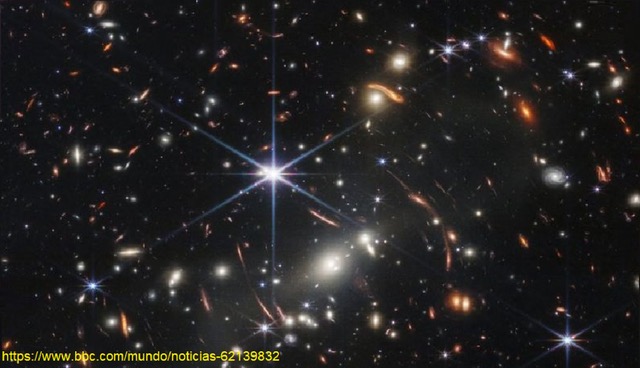
May showers, the Aquarids
The entry, at high speed, of a meteoroid into the Earth's atmosphere is known as a meteor. When interacting with the particles of the atmosphere, it produces a brightness that makes the phenomenon observable, which is why these flashes of light are sometimes called shooting stars or meteor showers.
The ?-Aquarids meteor shower will be active from April 19 to May 28, with its maximum on May 6. The maximum observable rate will be 40 meteors per hour. The radiant is in the direction of the constellation Aquarius, towards the eastern part of the celestial sphere. The propelling object of this shower has been determined to be Comet 1P/Halley. The shower will be observable in the early hours of May 6, although moonlight will cause some significant interference.
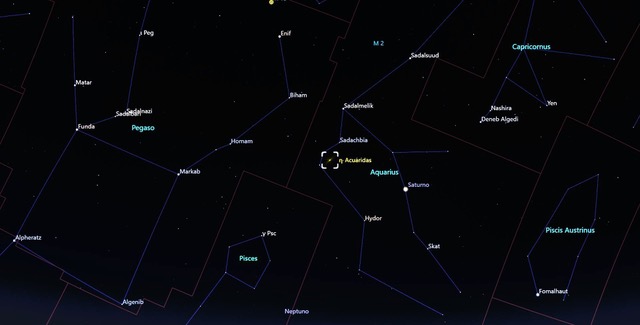
A true galactic relic
The globular cluster M5, NGC 5904 or Pink Cluster, in the constellation of the Serpent, is a favorite among amateur astronomers, due to its easy search and observation. First observed in 1702 by Gotffried Kirch and Maria Margareth Winkelmann-Kirch, Messier rediscovered and cataloged it in 1764, describing it as a nebular object. With 100,000 stars in a region with a diameter of 130 light years, located 24,500 light years from us, it becomes one of the largest, while its estimated age
13 billion years old, making it one of the oldest objects in our galaxy. Under the best viewing conditions, it can be seen with the naked eye, while with binoculars it is possible to distinguish it as a small hazy patch. A small telescope will allow us to appreciate more details, such as a bright central cloud, and with a telescope larger than 10 cm aperture, even more details, such as bright concentric rings and some stars, can be resolved.
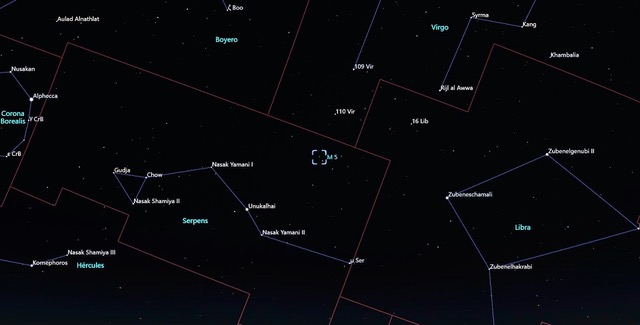
A mythological cluster
Surely the name of Hercules, the mythological hero, is familiar to you. Heracles (Hercules) born in the Greek city of Thebes, was the son of Zeus and Alcmena, a mortal, which made him a demigod. This provoked the anger of the goddess Hera, the lawful wife of Zeus, who always sought to eliminate Hercules. One of the most popular legends around Hercules is that of "the twelve labors", imposed as punishment for having sacrificed his children, nephews and wife under the influence of anger, caused by the goddess Hera. Finally, he put an end to his existence by putting on the cape of the centaur Neso, which they had given him, and when he put it on he began to burn and engulfed him in flames. Zeus was moved and decided to immortalize him among the stars, naming a constellation after him.
In the constellation of Hercules we find a globular cluster, the Great Hercules Cluster, technically known as M13 or NGC 6205. It was discovered by Edmond Halley in 1714 and cataloged by Pierre Messier in 1764. M13 is considered to be located 25,100 light-years from us, has a diameter calculated at 145 light years and contains about 100,000 stars. With its apparent magnitude of 5.8, M13 is easily visible with binoculars and small telescopes. In 1974, he was selected to send a signal with the now extinct Arecibo radio telescope in search of extraterrestrial civilizations.
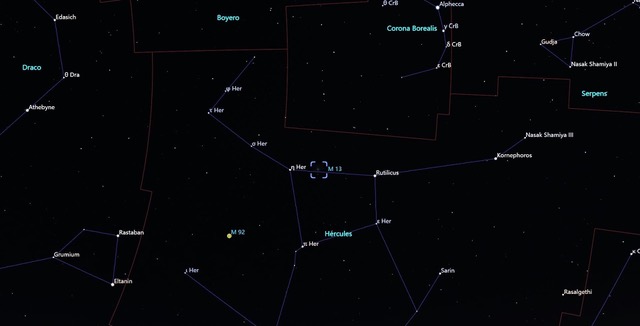
A Crab in a Scorpion?
In the constellation of the Scorpion we locate a red supergiant star called Antares and very close to it we can locate the globular cluster M4 or Crab Cluster, it is one of the closest, located only 7,500 light years from us. It was discovered by De Chéseaux between 1745-46, but it was not until 1764 when Messier included it in his famous catalogue, with the number 4, M4 being the first cluster to be resolved as a “cluster of very small stars”. Finally, in 1784, William Herschel was able to resolve this and all of Messier's globular clusters with his large telescopes. This is one of the most observed clusters. In 1995, thanks to the Hubble Space Telescope, some white dwarf stars were discovered, almost as old as our galaxy, and a superjovian planet was found orbiting one of these stars. Surely there will still be thousands of objects and knowledge that this ancient cluster of almost 13,000 million years keeps.
This cluster is bright enough, with an apparent magnitude of 5.6, and an angular size of 36 arc minutes (almost the same as the Moon, which is 30 arc minutes), to be observed either with the naked eye (in places free from light pollution), or near cities, with binoculars or small telescopes. It is located in the direction of the constellation of the Scorpion, towards the southeast of the celestial sphere.
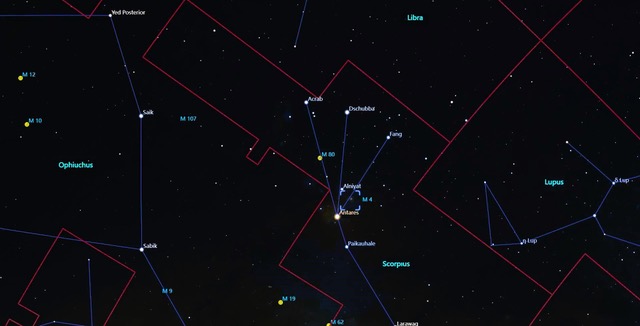
Pictures worthy of a postcard
On May 23 and 24, the Moon will have conjunctions with the planets Venus and Mars. The Moon will be first, on the 23rd, in conjunction with Venus, with a distance of only 2° 12' between them, and on the 24th the conjunction of the Moon and Mars will occur, that is, both objects share one of their coordinates, the Ascension Straight, when the Moon passes 3° 45' north of Mars. It is worth mentioning that at the time of both conjunctions the objects will be below the horizon, but the sunsets of May 23 and 24 will give us the opportunity to observe images of the Moon visiting Venus in the constellation of Gemini and of the Moon visiting Mars in the constellation Cancer, respectively.
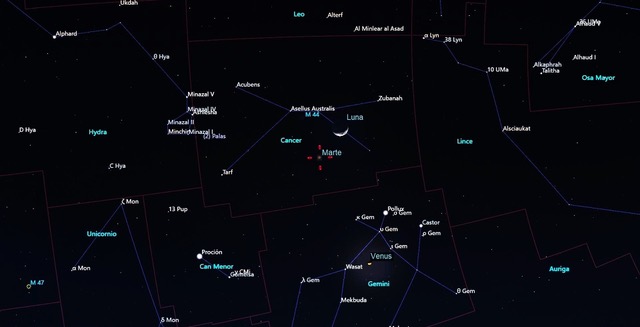
Phases of the Moon (Central Mexico time)
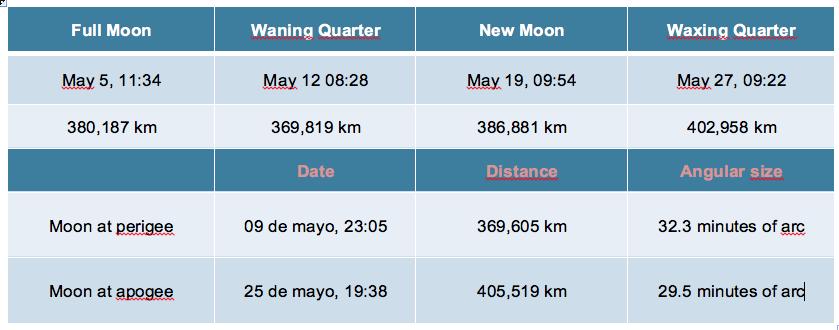
The video with the astronomical events of the first week of May 2023 can be consulted in the following link: https://youtu.be/yT89P5bfjCw, the following weeks will appear on our social networks.
Contacts:
Dr. Agustín Márquez Limón (amarquez@inaoep.mx), Coordinación de Astrofísica-INAOE
Dr. Vicente Hernández Hernández (planetariodecozumel@gmail.com), Red de Planetarios del Estado de Quintana Roo
Dr. Raúl Mújica García, (rmujica@inaoep.mx), Coordinación de Astrofísica-INAOE y Noche de las Estrellas
Luis Enrique Erro # 1, Tonantzintla, Puebla, México, Código Postal 72840, Tel: (222) 266.31.00, difusion@inaoep.mx
This work is licensed under a Creative Commons Attribution-NonCommercial-NoDerivs 2.5 Mexico License.


